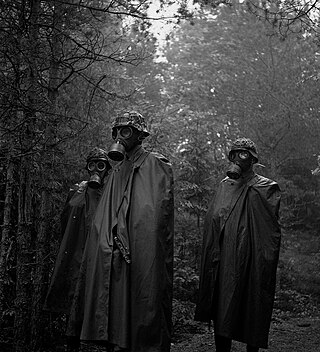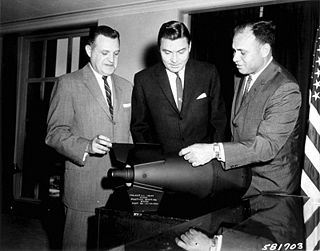Related Research Articles

Nuclear warfare, also known as atomic warfare, is a military conflict or prepared political strategy that deploys nuclear weaponry. Nuclear weapons are weapons of mass destruction; in contrast to conventional warfare, nuclear warfare can produce destruction in a much shorter time and can have a long-lasting radiological result. A major nuclear exchange would likely have long-term effects, primarily from the fallout released, and could also lead to secondary effects, such as "nuclear winter", nuclear famine, and societal collapse. A global thermonuclear war with Cold War-era stockpiles, or even with the current smaller stockpiles, may lead to various scenarios including the extinction of the human species.

In nuclear strategy, a first strike or preemptive strike is a preemptive surprise attack employing overwhelming force. First strike capability is a country's ability to defeat another nuclear power by destroying its arsenal to the point where the attacking country can survive the weakened retaliation while the opposing side is left unable to continue war. The preferred methodology is to attack the opponent's strategic nuclear weapon facilities, command and control sites, and storage depots first. The strategy is called counterforce.
Mutual assured destruction (MAD) is a doctrine of military strategy and national security policy which posits that a full-scale use of nuclear weapons by an attacker on a nuclear-armed defender with second-strike capabilities would result in the complete annihilation of both the attacker and the defender. It is based on the theory of rational deterrence, which holds that the threat of using strong weapons against the enemy prevents the enemy's use of those same weapons. The strategy is a form of Nash equilibrium in which, once armed, neither side has any incentive to initiate a conflict or to disarm.

In nuclear ethics and deterrence theory, no first use (NFU) refers to a type of pledge or policy wherein a nuclear power formally refrains from the use of nuclear weapons or other weapons of mass destruction (WMD) in warfare, except for as a second strike in retaliation to an attack by an enemy power using WMD. Such a pledge would allow for a unique state of affairs in which a given nuclear power can be engaged in a conflict of conventional weaponry while it formally forswears any of the strategic advantages of nuclear weapons, provided the enemy power does not possess or utilize any such weapons of their own. The concept is primarily invoked in reference to nuclear mutually assured destruction but has also been applied to chemical and biological warfare, as is the case of the official WMD policy of India.

A weapon of mass destruction (WMD) is a biological, chemical, radiological, nuclear, or any other weapon that can kill or significantly harm many people or cause great damage to artificial structures, natural structures, or the biosphere. The scope and usage of the term has evolved and been disputed, often signifying more politically than technically. Originally coined in reference to aerial bombing with chemical explosives during World War II, it has later come to refer to large-scale weaponry of warfare-related technologies, such as biological, chemical, radiological, or nuclear warfare.
Nuclear utilization target selection (NUTS) is a hypothesis regarding the use of nuclear weapons often contrasted with mutually assured destruction (MAD). NUTS theory at its most basic level asserts that it is possible for a limited nuclear exchange to occur and that nuclear weapons are simply one more rung on the ladder of escalation pioneered by Herman Kahn. This leads to a number of other conclusions regarding the potential uses of and responses to nuclear weapons.
Military doctrine is the expression of how military forces contribute to campaigns, major operations, battles, and engagements. A military doctrine outlines what military means should be used, how forces should be structured, where forces should be deployed, and the modes of cooperation between types of forces. "Joint doctrine" refers to the doctrines shared and aligned by multinational forces or joint service operations.
AirLand Battle was the overall conceptual framework that formed the basis of the US Army's European warfighting doctrine from 1982 into the late 1990s. AirLand Battle emphasized close coordination between land forces acting as an aggressively maneuvering defense, and air forces attacking rear-echelon forces feeding those front line enemy forces. AirLand Battle replaced 1976's "Active Defense" doctrine, and was itself replaced by "Full Spectrum Operations" in 2001.

The Single Integrated Operational Plan (SIOP) was the United States' general plan for nuclear war from 1961 to 2003. The SIOP gave the President of the United States a range of targeting options, and described launch procedures and target sets against which nuclear weapons would be launched. The plan integrated the capabilities of the nuclear triad of strategic bombers, land-based intercontinental ballistic missiles (ICBM), and sea-based submarine-launched ballistic missiles (SLBM). The SIOP was a highly classified document, and was one of the most secret and sensitive issues in U.S. national security policy.

Massive retaliation, also known as a massive response or massive deterrence, is a military doctrine and nuclear strategy in which a state commits itself to retaliate in much greater force in the event of an attack. It is associated with the U.S. national security policy of the Eisenhower administration during the early stages of the Cold War.

The Nuclear Posture Review (NPR) is a process “to determine what the role of nuclear weapons in U.S. security strategy should be.” NPRs are the primary document for determining U.S. strategy for nuclear weapons and it outlines an overview of U.S. nuclear capabilities, changes to current stockpiles and capabilities, plans for deterrence, and plans for arms control policy with other nations.

Flexible response was a defense strategy implemented by John F. Kennedy in 1961 to address the Kennedy administration's skepticism of Dwight Eisenhower's New Look and its policy of massive retaliation. Flexible response calls for mutual deterrence at strategic, tactical, and conventional levels, giving the United States the capability to respond to aggression across the spectrum of war, not limited only to nuclear arms.

An NBC suit, also called a chem suit, or chemical suit is a type of military personal protective equipment. NBC suits are designed to provide protection against direct contact with and contamination by radioactive, biological, or chemical substances, and provide protection from contamination with radioactive materials and all types of radiation. They are generally designed to be worn for extended periods to allow the wearer to fight while under threat of or under actual nuclear, biological, or chemical attack. The civilian equivalent is the hazmat suit. The term NBC has been replaced by CBRN, with the addition of the new threat of radiological weapons.

A tactical nuclear weapon (TNW) or non-strategic nuclear weapon (NSNW) is a nuclear weapon that is designed to be used on a battlefield in military situations, mostly with friendly forces in proximity and perhaps even on contested friendly territory. Generally smaller in explosive power, they are defined in contrast to strategic nuclear weapons, which are designed mostly to be targeted at the enemy interior far away from the war front against military bases, cities, towns, arms industries, and other hardened or larger-area targets to damage the enemy's ability to wage war. As of 2024, no tactical nuclear weapons have ever been used in combat.
In military doctrine, countervalue is the targeting of an opponent's assets that are of value but not actually a military threat, such as cities and civilian populations. Counterforce is the targeting of an opponent's military forces and facilities. The Oxford English Dictionary, 2nd ed., records the first use of the word in 1660 and the first use in the modern sense in 1965 in which it is described as a "euphemism for attacking cities".
Philip Jarvis Dolan was an American physicist. He graduated from West Point in 1945, was assigned to the Manhattan Project in Los Alamos in 1948, and received his MSc in physics from the University of Virginia in 1956.
This article deals with activities of the U.S. Central Intelligence Agency, specifically dealing with arms control, weapons of mass destruction (WMD) and weapons proliferation. It attempts to look at the process of tasking and analyzing, rather than the problem itself, other than whether the CIA's efforts match its legal mandate or assists in treaty compliance. In some cases, the details of a country's programs are introduced because they present a problem in analysis. For example, if Country X's policymakers truly believe in certain history that may not actually be factual, an analyst trying to understand Country X's policymakers needs to be able to understand their approach to an issue.
The "Schlesinger Doctrine" is the name, given by the press, to a major re-alignment of United States nuclear strike policy that was announced in January 1974 by the US Secretary of Defense, James Schlesinger. It outlined a broad selection of counterforce options against a wide variety of potential enemy actions, a major change from earlier SIOP policies of the Kennedy and Johnson eras that focused on Mutually Assured Destruction and typically included only one or two "all-out" plans of action that used the entire U.S. nuclear arsenal in a single strike. A key element of the new plans were a variety of limited strikes solely against enemy military targets while ensuring the survivability of the U.S. second-strike capability, which was intended to leave an opening for a negotiated settlement.
The military doctrine of Russia is a strategic planning document of the Russian Federation, representing a system of official state-adopted views on preparation and usage of the Russian Armed Forces. The most recent revision of the military doctrine was approved in 2014.
Proud Prophet was a war game played by the United States that began on June 20, 1983, and was designed by Thomas Schelling. The simulation was played in real time during the Cold War. Proud Prophet was essentially played to test out various proposals and strategies, in response to the Soviet Union's military buildup. There were advocates for a number of strategies, which varied from demonstration nuclear attacks, limited nuclear war, and decapitation attacks. It was not possible for the United States to pursue each of these strategies. President Ronald Reagan and his administration were faced with the dilemma of figuring out how the United States should respond to the Soviet Union's large nuclear programs, while finding which strategy would be most effective.
References
- ↑ Walter Pincus (11 September 2005). "Pentagon Revises Nuclear Strike Plan". The Washington Post. Retrieved 9 April 2010.
- ↑ Pentagon Cancels Controversial Nuclear Doctrine, 2 February 2006, FAS
- ↑ U.S. Nuclear Weapons Guidance, last update 16 March 2006, FAS
- ↑ David E. Sanger; Peter Baker (5 April 2010). "Obama Limits When U.S. Would Use Nuclear Arms". The New York Times. Retrieved 8 April 2010.